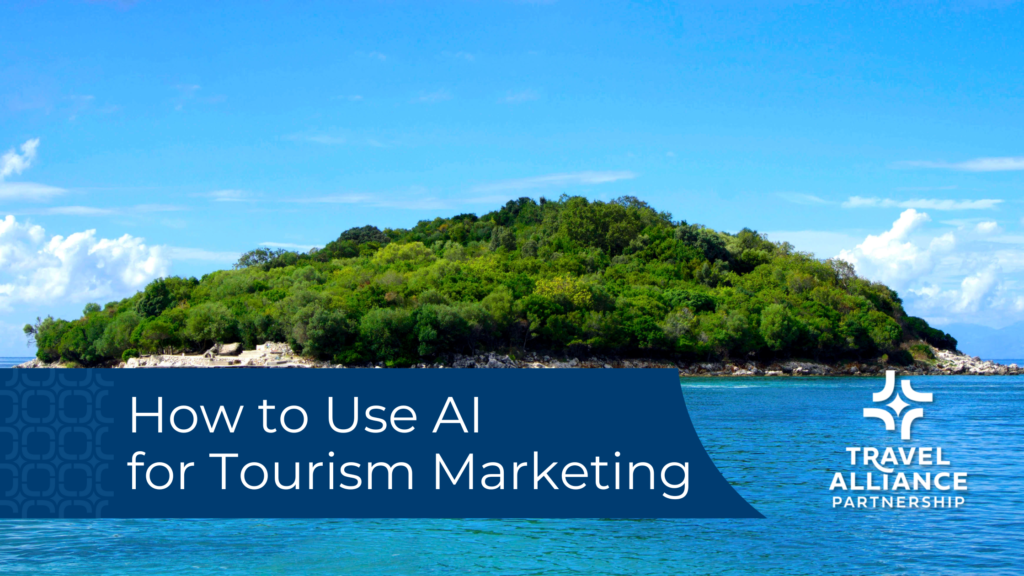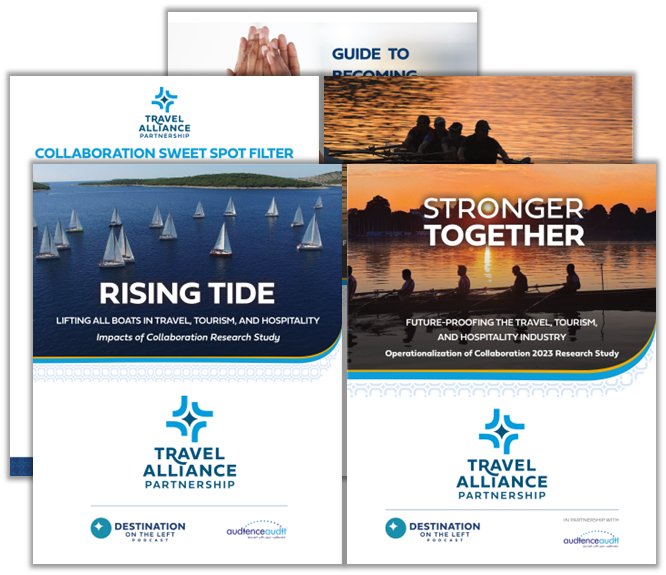How to Use AI For Tourism Marketing
Artificial Intelligence is a top trend in every space right now. It is transcending digital and becoming part of the conversation for just about everything we do. Of course, this hot topic is coming up in our meetings with clients and vendors, and internally on our team. Reactions to AI range from excitement to fear, confusion to apathy. Today I’ll share with you why we’re excited, not afraid. Let’s take a look at how to use AI for tourism marketing.

How we use AI
AI is a tool. It’s a powerful tool, no doubt, but this is not Terminator. ChatGPT and tools like it are simply that – tools. It cannot replace our unique human creativity and critical thinking skills. AI can be used to supplement creativity, find efficiencies and assist productivity. We always thoroughly review and edit anything produced with AI assistance.
Anything done with AI still needs a human touch – or even a heavy hand – in editing. AI can even help to edit itself, as long as a human eye has the last look. My favorite way to talk about AI is as “our digital intern.” Not an intern specializing in tech, but rather a technology tool that acts as an intern. Just as you would check anyone else’s work for accuracy, typos, style and brand voice, the same goes for your AI “assistants.”
Drafts
AI can be a tool for writing first drafts of some content. One of our favorite AI tools for marketers called Jasper, is known for its writing skills. Tell the tool your main points and other supporting information like style and tone, and it will spit out a first draft. An important point to note about AI first drafts is that they are known for being over-the-top with adjectives, overly formal or flowery.
Top tips for using AI on any draft:
- Be as specific as possible in your prompts.
- Starting small, ask it for one piece of content at a time, not a week’s worth of social posts.
- Ask for three versions and you can piece together the best parts.
Editing with AI
What AI is even better at helping with is editing content that you (or another human) already wrote. Refining and rephrasing content is the strong suit. The above tips still work in this case, and I also like to be specific in what I’m asking the AI to do when it edits.
Using AI to edit – no matter who drafted the content – is a chat-worthy process. Give your AI tool direct feedback like “that’s too salesy” or “use fewer adjectives” or “I want the tone to be friendly, not sappy.” The tool will give you a revised version. I also sometimes ask it to review or refine a version I wrote based on all of the back-and-forth.
Naming
AI comes up with fun, clever names and snappy headlines and email subject lines in seconds. So often, we spend time coming up with the “just right” name for an event or themed itinerary when we could be planning the event or mapping out the itinerary (not pieces I would totally trust AI with just yet). AI is great at these – try it out and see what you get!
Summarizing
Another fantastic use for AI tools is creating summaries. Feed in your meeting notes, research notes or long-form feedback from your audience and ask AI for a summary. It can also pull out some themes to organize your thoughts or a report.
How we don’t use AI
We never use AI to create a final version of anything without human intervention. Even those snappy headlines in the example above will need tweaking. This is where the conversation with AI comes in, giving it feedback to come up with better and better versions until you find one you like. Sometimes, it’s straight editing. One other tactic for editing AI content is to have AI draft a few versions, then weave your favorite parts together into a human-touched final version.
Privacy
Unless you have the paid version of ChatGPT and have enabled privacy settings, the recommendations we’re hearing now is to never enter proprietary information into an AI tool. So that means no client, sensitive or proprietary data goes in to AI as a chat prompt or file upload. Open-source Large Language Models are designed to learn from all the data entered, so it’s best not to feed in anything that isn’t already accessible publicly.
AI and Visuals
AI-generated imagery and other creative works – authors are very wary of AI usage – are shrouded in some controversy. When it comes to visuals and art, the concern is over how the AI tools learned to create art and copyright concerns for artists whose works were learned from. Many marketers are using AI art, images and graphics now with the understanding that just like copy drafts, the art drafted by AI needs edits. Some digital artists are embracing AI as a tool, and are creating very cool works using its power, and their own personal creativity.
There are so many AI tools for generating visuals, editing images, cutting together videos and other graphics. Dall E is the open source version put out by OpenAI, creators of ChatGPT. Adobe’s Firefly tool is another popular one for those using the Creative Suite. We have dabbled in AI-generated images and use them for creative ideas in proposals, social media graphics and ads.
AI Tools for Tourism Marketing Innovation & Creativity
Our favorite tools for content are Jasper and ChatGPT, and those are a great place to start as you are experimenting in using AI for tourism marketing purposes. They write well and take direction on the project, just as if you were delegating it to someone. You just get the result in seconds instead of hours or days! There are so many resources available right now on creative ways to use AI
There are so many tools to try out, and so many different uses. From Seamless.AI and Apollo.io for sales prospecting, to PressPal by MuckRack for PR and Yoodli speech coach. Scribe AI can write down your processes (like how you use collaboration in your organization…) and all the big names in tech are developing their own. You may have already seen that Google, Zoom and Microsoft have AI tools now available. There are even websites dedicated to finding the right AI tool, although I’m partial to just asking ChatGPT for what it suggests.
Author
Related Posts
How Curated Experiences Can Help Your Tourism Marketing
In years past, travelers may have been satisfied to see sites like the Eiffel Tower or Colosseum; now they want to get behind the scenes,...
Marketing for Group Travel: Building Solid Relationships with Tour Operators
Group travel is a significant segment of the tourism market, and if you want to see those buses pulling up to the curb and filling…
